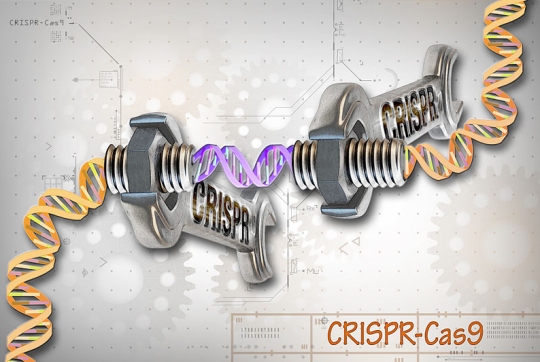More Accurate Gene Editing: The Promise Of Enhanced CRISPR Technology

Table of Contents
Addressing Off-Target Effects in CRISPR-Cas9
Off-target effects, or unintended edits at locations other than the target gene sequence, represent a major limitation of traditional CRISPR-Cas9. These unintended modifications can lead to increased risk of unwanted mutations and harmful side effects, hindering the therapeutic potential of this technology. To mitigate these risks, researchers are employing several strategies for more accurate gene editing:
-
Improved guide RNA design: Careful selection and optimization of guide RNA (gRNA) sequences are critical for minimizing off-target effects. Using multiple gRNAs targeting different regions of the target gene can enhance specificity. Modifications to the gRNA structure can also improve binding affinity and reduce non-specific binding.
-
High-fidelity Cas9 variants: Engineered variants of the Cas9 enzyme, such as SpCas9-HF1 and eSpCas9(1.1), exhibit significantly improved specificity compared to wild-type Cas9. These variants have been modified to reduce their propensity for binding to non-target DNA sequences.
-
Base editors and prime editors: These advanced gene editing tools offer precise single-base modifications without creating double-strand breaks (DSBs), a common cause of off-target effects in traditional CRISPR-Cas9. Base editors convert one base to another, while prime editors can perform a broader range of edits, including insertions and deletions.
-
Computational tools: Sophisticated computational tools are being developed to predict potential off-target sites and guide the design of more specific gRNAs. These tools analyze the genome sequence and identify regions with high similarity to the target sequence, allowing researchers to select gRNAs with minimal off-target potential.
Enhanced Targeting Specificity through Guide RNA Design
The guide RNA plays a central role in directing the Cas9 enzyme to the target DNA sequence. Improvements in gRNA design are crucial for achieving more accurate gene editing. Recent advancements include:
-
Multiplexed gRNA delivery: Using multiple gRNAs simultaneously, each targeting a different region of the target gene, can improve the precision and efficiency of gene editing while also reducing off-target events.
-
Chemical modifications: Modifying the chemical structure of the gRNA can enhance its binding affinity and specificity to the target DNA sequence. This improves on-target activity while reducing off-target cleavage.
-
Machine learning algorithms: Machine learning approaches are increasingly used to design and optimize gRNA sequences. These algorithms analyze large datasets of gRNA sequences and their corresponding on-target and off-target activities to identify optimal gRNA candidates with high specificity and efficiency.
Exploring Novel CRISPR Systems for Increased Precision
While Cas9 is the most widely used CRISPR enzyme, other CRISPR systems are emerging with enhanced targeting capabilities. For example:
-
Cas12a (Cpf1): This enzyme offers advantages over Cas9, exhibiting higher specificity and recognizing a different type of target DNA sequence (T-rich PAM). Its smaller size also makes it easier to deliver into cells.
-
Other emerging systems: Researchers continue to discover and characterize novel CRISPR systems from diverse bacterial species, each potentially offering unique advantages in terms of specificity, target range, and ease of use. These systems hold great promise for future advancements in more accurate gene editing.
Base Editing and Prime Editing: Precise Modifications Without Double-Strand Breaks
Base editing and prime editing represent significant advancements in more accurate gene editing. These methods enable precise single-base modifications without creating DSBs, a major source of off-target effects in traditional CRISPR-Cas9:
-
Base editors: These fusion proteins consist of a deactivated Cas9 enzyme fused to a deaminase enzyme, allowing for the precise conversion of one base to another without causing a double-stranded break.
-
Prime editors: These are more versatile than base editors, capable of performing a wider range of edits, including insertions, deletions, and all types of base-to-base conversions. They achieve this by using a reverse transcriptase enzyme to synthesize a modified DNA strand.
-
Reduced off-target effects: The targeted nature of base and prime editing minimizes off-target effects, making them safer and more efficient for therapeutic applications.
Applications of More Accurate Gene Editing in Medicine and Research
The enhanced accuracy of CRISPR technology is revolutionizing various fields:
-
Gene therapy: More accurate gene editing allows for the correction of disease-causing mutations in inherited disorders such as sickle cell anemia, cystic fibrosis, and Huntington's disease.
-
Cancer immunotherapy: CRISPR can be used to engineer immune cells, enhancing their ability to target and destroy cancer cells with improved specificity.
-
Disease modeling: Precise gene editing is crucial for creating accurate disease models in cells and animals, which are invaluable for studying disease mechanisms and developing new therapies.
-
Agricultural applications: More accurate gene editing is being used to improve crop yields, enhance nutritional value, and increase resistance to pests and diseases.
The Future of More Accurate Gene Editing
The pursuit of more accurate gene editing is driving innovation in CRISPR technology, paving the way for safer and more effective therapies and research applications. Advancements in gRNA design, high-fidelity Cas9 variants, novel CRISPR systems, base editing, and prime editing are all contributing to this progress. Overcoming the limitations of traditional CRISPR is unlocking the full potential of gene editing in various fields. Continued advancements promise a future where gene editing can precisely target and correct genetic defects, revolutionizing healthcare and beyond.
Stay updated on the latest developments in more accurate gene editing and explore the possibilities of this groundbreaking technology.

Featured Posts
-
 Insufficient Rainfall In March Water Deficit Remains
May 30, 2025
Insufficient Rainfall In March Water Deficit Remains
May 30, 2025 -
 Trump Administration Rejects 3 Billion Sunnova Energy Loan
May 30, 2025
Trump Administration Rejects 3 Billion Sunnova Energy Loan
May 30, 2025 -
 Negociations Sur L Age De Depart A La Retraite Un Possible Accord Rn Gauche
May 30, 2025
Negociations Sur L Age De Depart A La Retraite Un Possible Accord Rn Gauche
May 30, 2025 -
 Laurent Jacobelli Un Profil Du Depute Rn De La Moselle
May 30, 2025
Laurent Jacobelli Un Profil Du Depute Rn De La Moselle
May 30, 2025 -
 Miami Open Ealas Quarterfinal Berth After Victory Against Keys
May 30, 2025
Miami Open Ealas Quarterfinal Berth After Victory Against Keys
May 30, 2025
